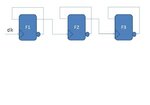rakko
Full Member level 4
Given this circuit, answer these questions;
1- what is it?
2- How does it work?
3- If clock freq. is increased, which flop fails 1st and why?
my guess is: down ring counter, counts from 7 down to zero and repeats, at high freq., the fastest flop meaning F1 fails 1st..... what do you think.
1- what is it?
2- How does it work?
3- If clock freq. is increased, which flop fails 1st and why?
my guess is: down ring counter, counts from 7 down to zero and repeats, at high freq., the fastest flop meaning F1 fails 1st..... what do you think.
